
*Space-Age Math in a Stone-Age World*
By: gvi
22 September 2014
Formatting edits 9 October 2014.

The seed of this essay was planted after the continued and repeated discussion of slide rules on the Rubicon suggested that some treatment of the broader topic of math without electronics was merited. Many Rubies own slide rules - the author included - and it seems natural that this more primitive technology might recommend itself at a time when the conveniences of modern life are absent either temporarily or for the foreseeable future. Some Rubies are relative newcomers to their slide rules, some are old hands who haven't pulled theirs out of storage since Carter was president; and some, who have never used a "slipstick" but see their utility, are now resolved to lay their hands on one and learn what makes it tick.
This is commendable. In the first place, the Rubies who are involved in this conversation see the value of perpetuating knowledge of mathematics after catastrophe. They think beyond mere grub-and-flint survival. What is more, there is an understanding that slide rules represent a technology which is more "resilient" in a preparedness context than pocket calculators or computers. This essay does a very good job of explaining its resiliency - the reader is encouraged to invest his time on it. Lastly, the slide rule has an uncanny ability to inspire an understanding and appreciation for the math it's called upon to do. It's different from a calculator in this respect and it's a hard thing to put one's finger on, but it's there all right…you just want to make the thing work, and making it work makes the user a better mathematician.
Slide rules are like gas masks. A gas mask is great for protecting the face, eyes, and lungs of the wearer from the effects of poison gases and toxic chemicals, but it cannot protect the wearer from contact on the skin or from cuts and scrapes. Some sort of coverall garment is needed in addition, as are gloves and boots. In the same way, the slide rule is great for math at certain levels, to certain degrees of precision, but it's not the only thing one might want or need.
This essay will address, in addition to the slide rule, two other things one might want or need in the line of mathematical aids. These other things are an abacus and a log table book. The reader will not find instructions to use these things in this essay. As previously mentioned, resources for additional learning will be linked at the end. There are excellent online training resources for the slide rule and the abacus. Log table books without exception have instructions on their use in the first chapter, so no links will be made for this important item. What we will talk about, however, is what these several things do, what they don't do and what to look for in terms of features. Each item will be discussed in its entirety, after which we will move on to the next item.
Before we even get into what they can do for us, we ought to spend a moment on the question of whether we even need the things. The level of mathematics you normally do today is probably about the same as the level of mathematics you will do after TSHTF. Assess your own needs and capabilities now, and you won't go far wrong. I normally use algebra and trigonometry on a daily basis. Much of this math is automated and done in a computer via commands typed into a computer-assisted drafting program - I do a lot more math than I realize I'm doing. After TSHTF, everything my computer does for me may very well have to be done by hand. That I can do everything I need to by hand makes me a more employable and useful member of society after such an event, far more so than those who've never done my job outside the environment of electronic aids.
This business of the math we do "behind the computer screen" needs to be taken into account. A cabinetmaker who uses design software may not think he's doing much math but in fact, if he wants to stay employable in a post-computer world (there will always be a need for skilled tradesmen), he needs to realize that a great deal of math is in fact being done "in his name" - it's just getting done via a computer. So in assessing our needs, we must be aware of how much math we do via computer and not just that which we do with pencil-and-paper.
If you do simple arithmetic now and no more, you'll likely be doing the same math later. Likewise, if you're doing calculus now, it'll be just your luck to have this skill called upon in the work of recovery and rebuilding. In between are the rest of us, who sometimes must do algebra "story problems" or something involving geometry or trig. This essay is largely written for this class of mathematician, though the arithmeticians may well benefit betimes from having an abacus or a slide rule handy.
Mechanical adding machines are lovely bits of engineering, but are either too heavy or too limited in scope to really be considered. You can't put a desktop adding machine in your backpack (well, you can, but...). Also, repair parts for these intricate machines are harder to find than typewriter parts now, to say nothing of finding them after a large catastrophe. I ain't the man to say you can't have one, but they won't be discussed here.
We will start with the simplest first - the abacus.
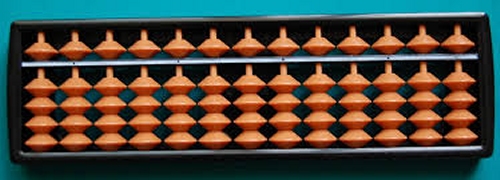
The word abacus refers to any math aid using beads on a wire or dowel. There are various types but to my thinking the most efficient is the one pictured above. It is of Japanese design and it is known in the Japanese language as a soroban. The Chinese call their version a suan pan. It can be distinguished from the one pictured by the presence of a second row of beads on top and five rows of beads on the bottom. The ancient Chinese number system was different from ours, and the Japanese abacus appeared in its present form around the 1930s (yes, that recently) when they as a nation decided to conform to Western, base-10 numbers.
I have one exactly like that pictured - it is made entirely of plastic. In addition, I have an antique "transitional" soroban I bought in a Korean antique shop in 1990. It is "transitional" in that it has a single row of beads on top and five on the bottom. It was made perhaps around the 1920s. Of the two, the smaller plastic one is the one I use - the antique one has only ever been for decoration.
The abacus is supposed to be able to handle multiplication and division, squares and roots. I'll take other people's word for it. I've only ever used mine for addition and subtraction. It is not so much a calculator as it is a memory aid, keeping places for you so you can concentrate on the math. In practiced hands it is MUCH quicker than a pocket calculator. Even without the abacus in hand, trained abacus users will often look into space, flicking their hands back-and-forth as though moving imaginary beads in their minds. Store clerks in Korea were still using them in the 90s, and operated them with amazing rapidity and perfect accuracy.
It is the most elegant aid to computation ever devised.
The Japanese abacus is easier to learn and use than the Chinese but the Chinese one will work just fine if it's the only thing you can get your hands on. All you do is ignore the extra beads. But they're also cheap enough that if you wanted to get a Japanese one, you can find just the one you want.
You'll see them in all kinds of sizes but the most common have either 15- or 17-columns. You may well see some with more than 20 columns and wonder what sort of gargantuan number the makers had in mind.
They didn't. The larger ones are so that the user can keep track of several calculations simultaneously in different places on the abacus.
Heck, they're so simple you could just go ahead and make one - there are several websites describing construction using simple materials. In fact, if you've ever made a "ranger bead" pace counter, you've already made one, as these are nothing more than an adaptation of the principle of the abacus.
Moving on from the abacus, we next arrive at the logarithm table.
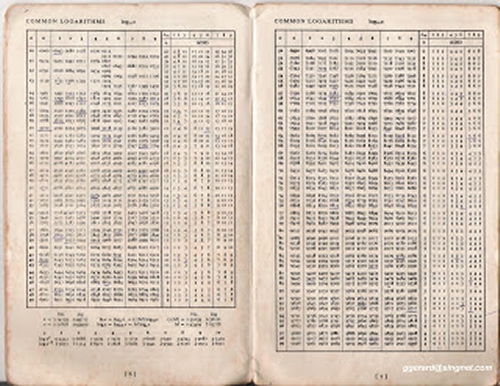
Logarithm tables are books, from near pamphlet-sized up to the size of the old hard-bound Reader's Digest condensed volumes. They look intimidating and complicated, but working with logarithms is not much more complicated than checkbook arithmetic combined with looking up numbers in a phone book (kids, ask your parents).
A logarithm (henceforward referred to for brevity's sake as a "log") is a sort of technicality in the laws of mathematics. It's not a number of anything - such as three cats, 250 rounds of ammunition, 48°15'24" or 8.3x1017 light years. It is a number which represents a "real-life" number. It's unnecessary to go much further; but the upshot of these "not-quite-numbers" is that if you add the logs of two "real-life" numbers, it's the same as multiplying the numbers themselves - the sum of two logs is the product of the two numbers they represent:
Conversely, subtracting one log from another is the exact same thing as dividing the first log's number by the second log's number:
Multiplying a log is the same as raising its representative number to the power you multiplied it by:
Conversely, dividing a log is the same as taking a root:
The symbol that looks like an over-achieving equal sign means "doing this is the functional equivalent of doing that."
It makes no sense to use logs if we're dealing with relatively small numbers. This would be needlessly cumbersome and more prone to error. But suppose we're doing something like:
That's an expression using the "law of cosines"…I didn't just make it up! The numbers in the expression are made-up, but represent the sort of numbers I'd use in my own line of work - the first is around a half-mile and the second is just proud of a quarter-mile.
An abacus isn't much use in this case, and as we'll see later on, neither is a slide rule. When learning my trade as a Field Artillery surveyor, I was trained to use a logarithm table book and not a slide rule. Log table books can work with numbers of up to seven significant figures (see APPENDIX - the triangle lengths above each have five significant figures and the angle has six).
To use a log table book, you look up a given number's logarithm according to the rules laid down in the first chapter. Writing that log down, you can then manipulate it and other logs accordingly (multiplying logs by two to square them as in the case of the first two numbers above) or adding them up as in the case of the second half of the equation. Once you're done, you "anti-log," or look up the resulting sum, difference, product or quotient.
For grins and giggles I worked the problem above using a log table book and with a calculator. Accounting for rounding-off, the numbers I got were equal. It was extraordinarily tedious with the log table but it took a heck of a lot less time than it would had I tried to do the math long-hand.
The best place to find log table books is online, at places like Alibris.com. Visit a used book site and type in "logarithm table" and you'll find many available for very little cost - the last one I picked up went for a dollar, plus shipping. You couldn't download and print off a log table for this small cost. The most common are "five-place" log books; that is, they will find logs for numbers with up to five significant figures. They will be smaller than normal textbooks nowadays - about the size of a student's bible and a third the thickness. Being seldom-used, they will be in excellent condition - at the price there is no need to settle for anything less - and will have many more tables than just the logs. The one on my desk as I type this essay has tables of logarithms, trig functions, simple and compound interest tables, haversines (for celestial navigation), several unit conversions, mathematical and scientific constants and so forth. They also have "natural" or "Napierian" log tables. Unless you know what you're looking at, these should probably be ignored - use the "common" logarithms.
Six-place books will be the same size only a bit thicker and will set you back maybe five or six dollars, again being cheaper than printing them off. Seven-place log books are the ones I mentioned earlier that are the size of Reader's Digest anthologies. These will often command a price commensurate with their size, but ought not to go for more than about $25.00 or so.
The bottom-line for the log table book is that it can handle math which is more complicated than an abacus can easily do, with numbers larger than a slide rule can handle. The cost is the tedium of working with them - There Ain't No Such Thing As A Free Lunch is truer in math than anywhere else.
Which finally brings us to…
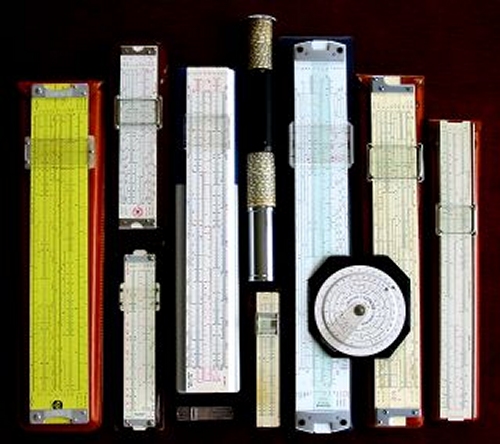
The slide rule's placement in this essay isn't a matter of "saving the best for last." A log table book can do things a slide rule can't, and the abacus is simpler.
Rather, it's placed here because there's so much to say of it. The slide rule is the Swiss Army Knife of pre-electronic math. It can do a lot of things almost as good as the dedicated tool can, and it all fits in a relatively small space.
Slide rules do most of the things a pocket scientific calculator will do: multiply, divide, find squares and square roots, cubes and cube roots, display trig functions, do calculations for circles easily, work out proportions and percentages (slide rules in fact do these better than electronic calculators). More complicated ones will show numbers raised to random powers, e.g. 3.24 3 etc. Certain specialized ones will have scales for electronics, or engineering, or radio or pipe sizes. Aviators still learn to use the E6B and many prefer it.
Slide rules don't add or subtract. Some among us may answer, "Sure they do - they add and subtract logarithms!"
To those tempted to give such a reply, I'm obliged to ask- didn't all the swirlies you got back in Jr. High School teach you ANYTHING?!
Back to work. There are many different kinds to choose from and most are available second-hand or even "new-old-stock," The latter tend to be more expensive but even here, a new-in-box slide rule with case and manual is usually less expensive - in today's money - than it was Way Back When, in Way-Back-When's money.
I got my first slide rule in the 1990s in college, long after their use had stopped being taught. I found it - a Post Versalog made in the early 70s - in a quirky office-supply store across the street from campus. It looked nice and the price was right - the truth is that for reasons already assigned, I had not the slightest idea what it was for or how to use it, but it looked cool in a "geek-chic" sort of way. The Versalog is a very good slide rule and in fact I just got lucky in my selection. It happens far more often than I'm proud to admit.
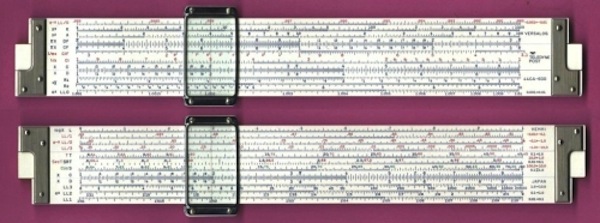
I've only started learning their use in earnest the last year or so and in that time, I've now assembled a small collection of several different kinds. Slide rules are the sort of thing where, once learned, you tend to go out of your way to look for opportunities to use it. If one has to have a vice, it would be hard to find a more innocent one. I slightly surprised myself the other day with the realization, when I found myself doing some routine calculation with a slide rule, that I hadn't taken my pocket calculator to work in over a month.
The slide rule museum linked at the bottom of the essay is the best resource for choosing and learning them, without question. If you have any interest at all in picking up a slide rule, go there first. Not only is their self-taught course the best - period - but they have an "adopt a slide rule" program which sells used slide rules at very reasonable prices. Sure, you could luck into a slide rule for less if you looked hard enough and visited enough garage sales or antique stores, but really - this is better. I'm of the opinion that it is better to pay a fair price to an expert than a cheap price to someone who can't really tell you what he's looking at.
As for what to look for in a slide rule, the first thing I would advise is to get one that's easy to read. Different makers inscribed their slide rules each in their own peculiar way. The scales were generally standard but the typeface of the letters and numbers, as well as the fineness of the graduation, all go into making any given slide rule easy for some people to read and difficult for others. Look at several kinds and see which are easiest on your eyes.
Next - and related to the first - stay away from six-inch "pocket" rules. As one Rubie wisely said, "IMHO the only good thing about them is they will fit in your pocket, which the 10 inch style won't. They are harder to read than 10 inch versions because they compress the same amount of information in just over half the length." This Rubie is a man worth listening to.
Slide rules are linear or circular (there are others but these are mostly for collectors). Linear slide rules were more common in their heyday and they are more readily available now. I have a circular slide rule and while it has advantages, its principal demerit is that the closer you get to the center of the circle, the less precision you get with the scales. If you are just learning them, stick with linear.
Lastly, condition and material are generally more important than how many scales the thing has. There is a good reason for saying so. One of our Rubies wants a relatively advanced K&E slide rule. I don't dare question his motives because it's his decision to make and he knows what he wants. The one he wants looks like this:
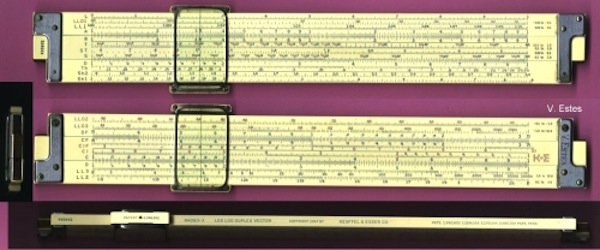
It's a darned good slide rule - I won't deny it. If I didn't already have my Versalog and like it so much I'm sure I'd want one as well - they're both in the same class in terms of complexity and workmanship. But in our search for one with the most capabilities, allow me to present the following:
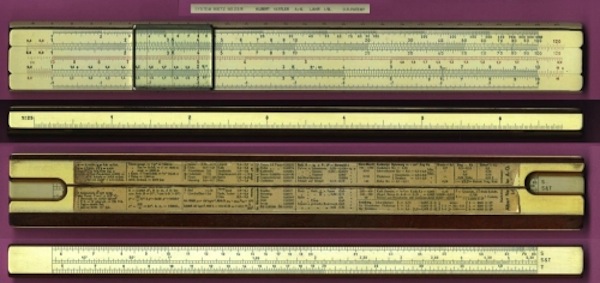
The slide rule above is the Nestler 23R. Look hard enough online and you'll see it is referred to as a "Mannheim" or, because of the trig functions on the back of the slide, a "Polyphase" slide rule (a trademark word developed by K & E which became "genericized" over time). These slide rules were, in the 20th century, generally considered "student's" slide rules in America and Asia. I have a similar one, a Post 1447, which I quite like. They were what you learned on in high school, before you went to college and got a "real" slide rule.
Now suppose I were to tell you that the Nestler 23R pictured above - the same one that was considered a "student" rule - was the preferred slide rule of both Werner Von Braun and Albert Einstien.
You may begin to see that it's not necessarily what the thing can do for you; but rather, what you can do with the thing!
This brings us to the most important point about non-electronic math aids. Far more than a pre-made spreadsheet or its pre-electronic forbear, the nomogram: http://myreckonings.com/wordpress/wp-content/uploads/JournalArticle/The_Lost_Art_of_Nomography.pdf, more even than a pocket calculator, the user of the abacus, log table or slide rule must know his or her math. They all require that the user think about what values are going into the problem being solved, and have some idea what the right number ought to look like or at least how big it ought to be. They all come from a period in history where the word "computer" in the dictionary defined a person and not a machine. They will not do your thinking for you. A pocket calculator won't either but it's easy to get lazy with them (see APPENDIX).
There is a benefit to this. Using these math aids in fact helps the user to grasp the math problem better. In particular, the slide rule shows all the relationships to the number in the problem - you can see right away if the answer looks reasonable or not. This results in the happy accident that, while you have to know your math to use them, using them helps you know your math better!
Between the slide rule, the log table and the abacus, there's not much math you can't do. They just take time.
Additional Resources:
For the abacus:
The Abacus Handbook
For the slide rule:
SlideRuleMuseum.com
APPENDIX - A Short Reminder on the Importance of Significant Digits.
Think back to all the stuff you learned in Jr. High School; rather, all the stuff you would have learned had you been paying attention (I wasn't either). One of them very likely was the concept of "significant digits." It is a fancy term for "The Only Numbers That Mean Anything."
Outside my house is a 60-year old Norway Maple tree. It is a beautiful specimen which bursts forth in dazzling yellow every autumn - the tree glows in the morning. To prove a point, just now, I went out to the tree with a fiberglass tape and measured its circumference. It is 6.30 feet around the tree.
The computer I'm typing this essay on has a calculator in it (a computer can compute? Who knew?!) I'm sure yours does too. If I want to know the diameter of the tree - a thing I must often report on land surveys - and I want to use the computer's handy feature, I can simply open the calculator program, type in 6.30 ÷ ∏ and hit [ENTER]. The calculator program tells me that the width of my tree is:
2.0053522829578812306879354184937 feet.
Umm…really?
Pi is the relationship of a circle's radius to its circumference. It is an irrational number that, so far as anyone knows, goes on forever. The first number - 6.30 - has but two significant digits (the zero doesn't count, though it was a measured value).
The concept of significant digits holds that an answer can be no more precise than the least precise number in the calculation. Since the least precise number in the calculation was the circumference, with only two significant digits, the answer can have no more than two. The answer is not that long-winded gobbledygook above, but rather 2.0 feet. But we sometimes forget this when we use a calculator because the calculator doesn't know.
My slide rule won't let me get away with that.
The easiest way to work the problem on a slide rule such as the one I just grabbed - my aluminum Pickett - is to simply use the DF scale. DF stands for "D Folded" or "the D scale 'folded' so it starts at Pi." Putting the cursor over 6.3 on the DF scale, I read the answer on D which turns out to be:
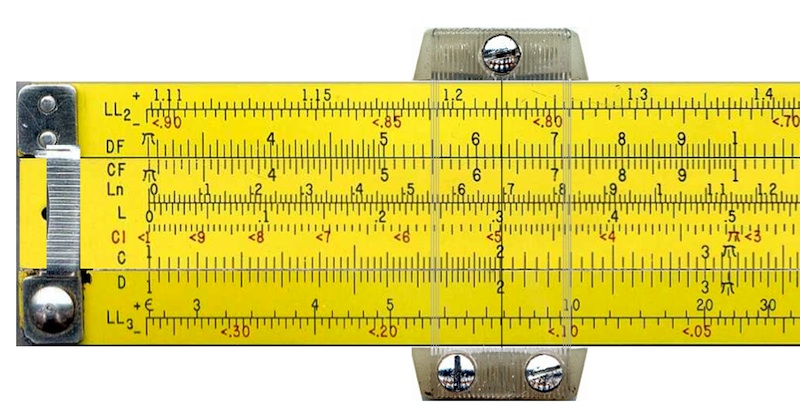
…which can only realistically be read as "2 and a pittance."
In this way, the slide rule "keeps it real." Beware unwarranted precision creeping into calculations.
gvi
www.alpharubicon.com
All materials at this site not otherwise credited are Copyright © 1996 - 2014 Trip Williams. All rights reserved. May be reproduced for personal use only. Use of any material contained herein is subject to stated terms or written permission.